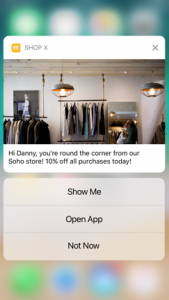 Apparently, humans now only concentrate for around eight seconds. For anyone who works in mobile marketing, this probably won’t come as a surprise: keeping users engaged and making sure your messages aren’t simply swiped away is a full-time job. So it’s worth noting that the secret to increasing customer interaction with your messaging might not be written in the words you’re sending out.
Apparently, humans now only concentrate for around eight seconds. For anyone who works in mobile marketing, this probably won’t come as a surprise: keeping users engaged and making sure your messages aren’t simply swiped away is a full-time job. So it’s worth noting that the secret to increasing customer interaction with your messaging might not be written in the words you’re sending out.
Studies have shown that our brains process images thousands of times faster than words, which in those key eight seconds of concentration can make the difference between users dismissing a message and clicking through with intent to act. By optimizing the non-verbal aspects of your interactions, engagement and retention can be significantly increased, making a clear difference to your ROI.
Think of the last time you opened up a new app. Chances are, you’ll be remembering the layout, colors, images, videos, and icons, rather than listing all the greetings, promises and requests you were faced with. You wouldn’t be alone: 91% of buyers prefer interactive and visual content over text-based and static media. These visual cues subtly point us towards certain actions, building a more streamlined user experience.
In addition, designing your app and notifications to suit both your brand and your target audience can develop a sense of who you are and what you do faster and more cohesively than a lengthy paragraph. Using rich push notifications means that you can extend this ‘visual grammar’ to all aspects of your communications, even when the user isn’t in your app.
Keep the following elements in mind for your next interactions, and you’ll avoid losing users before they’ve even read a word.
A/B Testing Images
The phrase ‘a picture tells a thousand words’ may not be novel, but it’s certainly true that if you’re looking to convey the maximum information in the minimum time, images can get the job done. The screens below show two great examples of this. Both are rich push notifications triggered by a geofence set up by the app, but the images they use engage the user in different ways.
For companies that sell something which appeals to people visually, like clothes or food, using an enticing photo could help them spot something they might like.
For services or products that are more useful than beautiful, a simple map showing just how close users are will remind them of the practicality.
Also Read: Swrve Introduces Intent Engine With Support for Real-Time Audience Profiling
However, although general principles like these are useful for gauging the right type of image, they’re no substitute for cold, hard analytics. Conducting A/B testing with variations on the images allows you to try out two (or three, or four) across your user base, seeing which triggers the highest response rate and nuancing your visual marketing to maximize results.

Rethink your calls to action
Push notifications, in-app messages, and tip overlays tread a fine line between being great marketing tools and being a nuisance to busy mobile users. Rather than trying to squeeze as much information and as many offers as possible into your character count, stick to one clear call to action that users notice straight away.
Deep linking your call to action to exactly where users need to be in the app minimizes the chances that you’ll lose them halfway to conversion. The text of your interactions could be worthy of a Pulitzer prize, but if your call to action dumps them at a home page, they’re not going to bother clicking around to complete the action.
If what you’re asking users to do needs more than a few more words, it’s time for a different approach. Videos are a powerful tool, and they’re ideal for saying what you need to without trying to crush it into a word count.
Videos have an even higher engagement rate than images, and once you’ve started watching, it’s hard to stop before the end. Rather than seeming like a sales message, a cleverly done video becomes an engaging piece of content.
Get the fit right
If something looks ‘off’ about the messages being sent out, users are less likely to pay attention to them. Since there’s no one-size-fits-all template for every mobile everywhere, smart systems (Swrve included, obviously) will resize images automatically, so that you don’t have to keep cropping and uploading. We also use a ‘safe zone’, which shows the portion of the uploaded image that will be displayed regardless of the model being used, so you can be sure that your buttons and calls to action won’t be cropped or stretched. Simple – and it ensures great work from your design team isn’t defeated in its first encounter with the real world.
Similarly, there are no one-size-fits-all-locations. Various cultures and markets respond to different visual prompts, and the same image can hold different cultural currency around the world. Localizing your messages to fit key markets takes a small investment in time but can improve click-through by up to 150%.
Recommended Read: Swrve Closes $25 Million Series D Funding Round To Bring Next Generation Marketing and Customer Experience To The Enterprise











